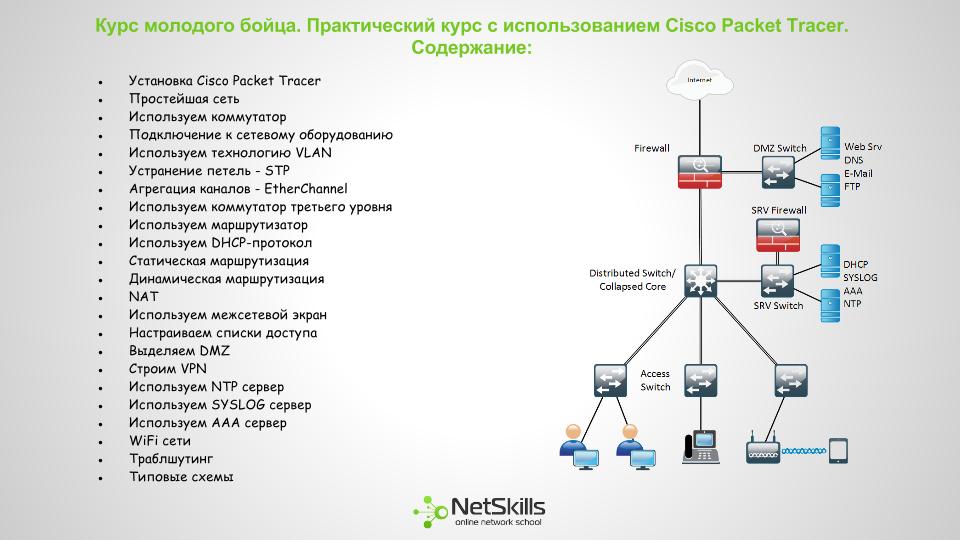The course of the young fighter. Cisco Packet Tracer Practical Course
Fast start
It all started about a couple of years ago. Working in a small company (system integrator) from a small city, I encountered a constant turnover of personnel. The specifics of the work is such that a system engineer in a very short time gets a lot of experience working with hardware and software from leading world vendors. The cost of such a person in the labor market immediately rises (especially if he manages to get a couple of certificates) and he simply leaves for a more paid job (leaves for rubber Moscow).
Naturally, the leadership did not like this situation, but there is nothing to be done. The only option available is to put the training of specialists on the conveyor. So that even a student after graduating from university can start working after two to three weeks of express training. So it was decided to form courses for training within the company in various areas. The development of a mini-course on the quick training of employees in setting up network equipment fell to my lot.
Actually after this, the creation of the “Young Fighter Course” on network technologies began.

Young fighter course
Perhaps the question immediately arises: "Why is the Cisco Packet Tracer, and not the more advanced GNS3?" Without a doubt, GNS3 is much better. But it’s better in terms of a detailed study of the functionality and for preparing for any exams. If a person has a faint idea of how networks work there, then it is better not to find Cisco Packet Tracer. It is very easy to learn and allows you to practice the basic functions of network equipment (VLAN, IP addressing, routing, etc.). It is suitable for a quick start.
Also, I did not want to draw up the next course on ICND textbooks, as In this case, the learning process was greatly delayed, and I still needed to prepare the person in a couple of weeks, so that he could go to the object and make some basic settings. Therefore, it was decided to draw up a course from the main topics that are most often encountered in practice, and give additional materials for independent training. As a result, several main topics for training were identified:
1) The simplest network - combining two computers into one network
2) Using a switch - combining several computers into one network
3) Connecting to network equipment - connecting and basic commands for configuration
4) VLAN - separation networks per segments
5) STP - loopback protection mechanism
6) EtherChannel - link aggregation
7) L3 switch - unlike a regular switch, scope
8) Router - difference from a L3 switch, scope
9) DHCP protocol - automatic distribution of ip-addresses
10) Static routing - the basics of routing traffic between networks
11) NAT - providing Internet access
12) Dynamic routing (OSPF, EIGRP) - for a more advanced study of routing
13) Access-List - access control
14) Firewall - difference from the router, area approx eneniya
15) DMZ - the organization of public services segment to
16) VPN - union branches
17) NTP, SYSLOG, AAA, TFTP - setting additional functions
18) WiFi - the basic principles of wireless networks
19) Troubleshooting - the main methods for finding problems
20) Typical schemes - the most frequently used solutions
According to the plan, after passing this mini-course, a person should be able to configure a small network according to a predetermined configuration.
Initially, it was very difficult to determine the method of presentation of the material and to realize whether the person understands the material provided. Therefore, it was decided to record small video lessons, after which they laid out on YouTube, where I could get feedback from “students”. This made it possible to slightly adjust classes. As a result, the lesson was divided into two parts:
1) A small theoretical introduction with additional resources for self-training
2) The practical part, including laboratory work in Cisco Packet Tracer
At the moment, I stopped at the DMZ lesson. The course now consists of 17 video lessons, which I continue to add. Below are a few lessons and a course playlist itself :
Conclusion
It is too early to judge the results of introducing training within the company based on our own courses. By summer, we expect an influx of students, on which we will be able to test our achievements. It will also become clear whether it is possible to prepare a person for such a short period of time (a couple of weeks). I repeat, the main objective of the course is the quick training of specialists in the rapidly changing composition of the Department of System Integration.
In the meantime, we continue to receive invaluable experience and feedback from virtual “students” on youtube. In the course of creating the course, problems were revealed that we had never suspected of before - starting from incorrect pronunciation of words, ending with incorrect examples in the laboratory work itself. All video tutorials are available for free. I hope that novice network engineers can get at least some useful information. Thus, the project, which began as a service (a task received from the management), gradually grew into something more. Now I already consider this lesson exclusively as a hobby, which, I hope, will bring something really worthwhile.
Thanks for attention.
PS
How do you deal with staff turnover? And how much time does the initial training of a new “green” employee take?
